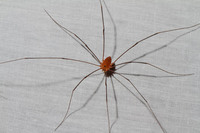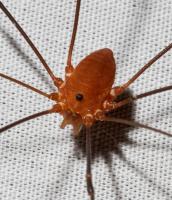Distribution Records
PDF
Vetting Levels |
|
Adult phenology:
High Mountains (HM) ≥ 4,000 ft.
Low Mountains (LM) < 4,000 ft.
Piedmont (Pd)
Coastal Plain (CP)
Click on graph to enlarge
|
 |
|
| synonym | |
| taxonomic_comments |
Approximately 30 species in this genus have been identified as occurring in North America north of Mexico (Cokendolpher and Lee, 1993; Ingianni et al., 2011), with 16 recorded in North Carolina. However, the validity of several of these species is suspect, with several that will probably be determined to be synonyms of other species, e.g., davisi, speciosum, and zimmermani in North Carolina Burns et al., 2012; Shultz, 2018). According to Shultz (2018), moreover, recent phylogenetic studies indicate both that more species are waiting to be described and that the name Leiobunum may eventually be restricted to European species, requiring new generic names for most, if not all, of our species. |
| species_comment |
Placed in the Leiobunum Politum Species Group by Burns et al. (2012) based on reproductive structures as well as genetic analysis. In North Carolina, this group also includes L. bracchiolum. |
| id_comments |
Males are golden-yellow to red-brown above, with no central figure on the abdomen; the ventral surface is similar in color but lighter. The palps are also similar in color as are the trochanters and basal portions of the femurs of the legs; the legs are dark brown distally (Davis, 1934). Females are yelowish- to reddish- to purplish brown, with a central figure that extends across the carapace and abdomen but is often somewhat incomplete; transverse bands of yellowish spots are present on the abdomen (Shultz, 2018). Leiobunum flavum is similar in color, including yellowish coxae, trochanters, and femur bases, but has more uniformly pale legs, is larger, and appears earlier in the season than politum. Leiobunum bracchiolum is also similar in appearance to politum but is slightly larger. Females have a central figure that is restricted to the abdomen (Shultz, 2018). Males may require dissection in order to distinguish politum from bracchiolum. |
| total_length |
4.8 mm, males; 6 mm, females (Davis, 1934) |
| structural_features |
Male and female reproductive structures are diagnostic (see Davis, 1934; Shultz, 2018) |
| silk_web |
|
| fld_guide_descriptions |
|
| online_photos |
BugGuide, The Harvestmen of Maryland |
| prey |
|
| predators |
|
| behavior |
|
| distribution_reference |
Davis (1934); Brimley (1938) |
| technical_reference |
Davis (1934); Shultz (2018) |
| adult_id | 1 identifiable by photo 2 identifiable by photo of specific features and/or supplementary info 3 identifiable from specimen only |
| abundance |
We currently have too few records from North Carolina to judge its frequency of occurrence or abundance |
| distribution_comments |
We have records from both the Piedmont and Mountains but some of these were made prior to the separation of bracchiolum from politum and need to be verified through collection of modern specimens |
checklist_mt_high
>=4,000 ft. | |
checklist_mt_low
<4,000 ft. | |
checklist_pd
Piedmont | |
checklist_cp
Coastal Plain | |
| habitat |
Found along forest edges in Maryland (Shultz, 2018) |
| observation_methods |
Shultz (2018) describes politum as more commonly found on the forest floor than bracchiolum, which is usually found up on vegetation |
| state_protection |
Arachnids are not protected under state law, although permits are needed to collect them in State Parks and other public and private nature preserves |
| NHP_ranks |
[GNR] [S3S5] |
| NHP_status |
|
| status_comments |
While this species does not appear to be habitat limited, but we need much more information on its distribution in the state, its habitat preferences, and population trends before we can begin to estimate its conservation status. |
Photo Gallery for Leiobunum politum No common name |
 | Recorded by: Steve Hall
Orange Co.
Comment: Identification based on trochanters concolorous with dorsum and a lack of a central figure; not collected |  | Recorded by: Steve Hall
Orange Co.
Comment: Identification based on trochanters concolorous with dorsum and a lack of a central figure; not collected |
|